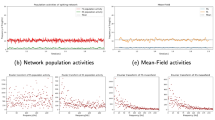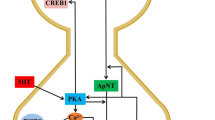Abstract
Stein's model for a neuron receiving randomly arriving post-synaptic potentials is studied from an analytic viewpoint, using some recent results in the theory of first passage times for temporally homogeneous Markov processes. The case when the only input is excitatory can be treated exactly. It is shown that the moments of the firing time are guaranteed to be finite so that the differential-difference equation for the expectation (and higher moments) of the time for the membrane potential to first reach threshold from resting level can be written down. Analytic solutions are obtained in a number of cases with main emphasis on the case when the threshold is twice the epsp magnitude. An invariance principie is formulated wherein at a given mean input frequency and for a given decay parameter, the distribution of firing times depends only on the ratio of threshld to epsp magnitude. For the case where this ratio is two, the variation in the mean discharge rate is obtained as a function of mean input frequency. The results are compared with the experimental data for the Poisson monosynaptic excitation of cat motoneurons by Redmanet al. Agreement between theoretical and experimental values is excellent at input frequencies near 102 sec-1, and theory underestimates the firing rate below that input frequency. Reasons for the discrepancy are discussed at length including the uncertainties in the neuronal parameters and the dependence of epsp magnitude on mean input frequency. The problem of including an inhibitory input process together with excitation is treated by an approximation procedure when the inhibition is considerably weaker than the excitation. At the input frequency investigated it is shown that when inhibition “half as weak” as the excitation occurs, the mean discharge frequency is approximately halved. In the final section a method of estimating neuronal parameters from the moments of the experimental inter-spike time distribution is outlined.
Similar content being viewed by others
References
Bishop, P.O., Levick, W.R., Williams, W.O.: Statistical analysis of the dark discharge of lateral geniculate neurones. J. Physiol. (Lond.)170, 598–612 (1964)
Capocelli, R.M., Ricciardi, L.M.: Diffusion approximation and first passage time problem for a model neuron. Kybernetik8, 214–223 (1971)
Clay, J.R., Goel, N.S.: Diffusion models for firing of a neuron with varying threshold. J. theor. Biol.39, 633–644 (1973)
Cox, D.R., Miller, H.D.: The theory of stochastic processes. New York: Wiley 1965
Curtis, D.R., Eccles, J.C.: Synaptic action during and after repetitive stimulation. J. Physiol. (Lond.)150, 374–398 (1960)
Darling, D.A., Siegert, A.J.F.: The first passage problem for a continuous Markov process. Ann. Math. Statist.24, 624–639 (1953)
Eccles, J.C.: The physiology of synapses. New York: Academic Press 1964
Gerstein, G.L., Mandelbrot, B.: Random walk models for the spike activity of a single neuron. Biophys. J.4, 41–67 (1964)
Gihman, I.I., Skorohod, A.V.: Stochastic Differential Equations. Berlin-Heidelberg-New York: Springer 1972
Gluss, B.: A model for neuron firing with exponential decay of potential resulting in diffusion equations for probability density. Bull. math. Biophys.29, 233–243 (1967)
Johannesma, P.I.M.: Diffusion models for the stochastic activity of neurons. In: E. R. Caianiello (Ed.) Neural Networks. Berlin-Heidelberg-New York: Springer 1968
Kolmodin, G.M., Skoglund, C.R.: Slow membrane potential changes accompanying excitation and inhibition in spinal moto-and interneurons in the cat during natural activation. Acta physiol. scand.44, 11–54 (1958)
Molnar, C.E., Pfeiffer, R.R.: Interpretation of Spontaneous spike discharge patterns of neurons in the cochlear nucleus. Proc. IEEE56, 993–1004 (1968)
Pfeiffer, R.R., Kiang, N.Y.-S.: Spike discharge patterns of spontaneous and continuously stimulated activity in the cochlear nucleus of anesthetized cats. Biophys. J.5, 301–316
Redman, S.J.: Thesis (Monash) 1967
Redman, S.J., Lampard, D.G.: Monosynaptic stochastic stimulation of cat spinal motoneurons. I. Response of motoneurons to sustained stimulation. J. Neurophysiol.31, 485–498 (1968a)
Redman, S.J., Lampard, D.G., Annal, P.: Monosynaptic stochastic stimulation of cat spinal motoneurons. II. Frequency transfer characteristics of tonically discharging motoneurons. J. Neurophysiol.31, 499–508 (1968b)
Rodieck, R.W., Kiang, N.Y.-S., Gerstein, G.L.: Some quantitative methods for the study of spontaneous activity of single neurons. Biophys. J.2, 351–368 (1962)
Roy, B.R., Smith, D.R.: Analysis of the exponential decay model of the neuron showing frequency threshold effects. Bull. math. Biophys.31, 341–357 (1969)
Skorohod, A.V.: Studies in the theory of Random Processes. Reading: Addison-Wesley 1965
Stein, R.B.: A theoretical analysis of neuronal variability. Biophys. J.5, 173–194 (1965)
Sugiyama, H., Moore, G.P., Perkel, D.H.: Solutions for a stochastic model of neuronal spike production. Math. Biosci.8, 323–341 (1970)
Tuckwell, H.C.: On the first exit time problem for temporally homogeneous Markov processes. J. appl. Prob. (in press) (1975)
Uhlenbeck, G.E., Ornstein, L.S.: On the theory of the Brownian motion. Phys. Rev.36, 823–841 (1930)
Author information
Authors and Affiliations
Rights and permissions
About this article
Cite this article
Tuckwell, H.C. Determination of the inter-spike times of neurons receiving randomly arriving post-synaptik potentials. Biol. Cybernetics 18, 225–237 (1975). https://doi.org/10.1007/BF00326692
Received:
Issue Date:
DOI: https://doi.org/10.1007/BF00326692




